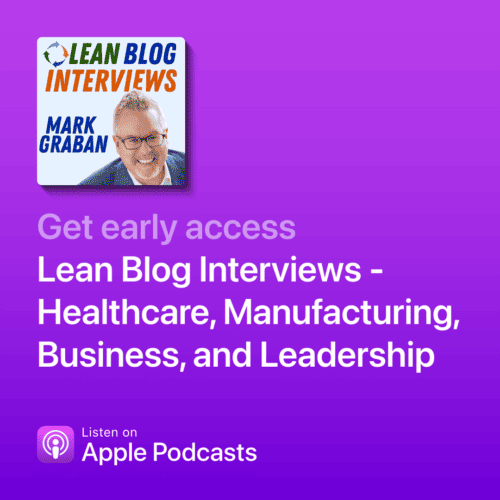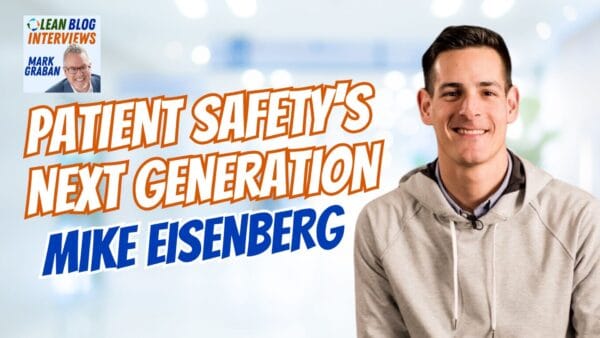Scroll down for how to subscribe, transcript, and more
My guest for Episode #523 of the Lean Blog Interviews Podcast is Mike Eisenberg. He's been a filmmaker since 2010 with his production company, Tall Tale Productions, after completing his B.A. in Journalism at Marietta College in Ohio.
Mike's father, Dr. John Eisenberg, was a leader in national patient safety efforts as the director of the Agency for Healthcare Research & Quality (AHRQ) until his passing in 2002. His legacy is prevalent throughout Mike's presentation, as well as his approach.
His new documentary, released last September, is titled “The Pitch: Patient Safety's Next Generation.”
He previously joined us in Episode #329, where we discussed his film “To Err is Human.”
In 2006, Mike was drafted by the Cleveland Indians in the MLB Draft and played 3 seasons of professional baseball before beginning his filmmaking career. He now speaks at hospitals, universities, and conferences, where his insight provides a new perspective on a problem that persists across the globe.
In today's episode, we explore the evolution of patient safety and the transformative role of technology in healthcare. The conversation dives into how innovations–from advanced command centers to cutting-edge virtual reality and AI applications–are redefining how hospitals prevent and respond to medical errors. The discussion challenges the conventional blame-and-shame approach and instead highlights the importance of building systems that foster trust and resilience among healthcare professionals and patients alike.
We also examine the nuances of integrating technology into complex healthcare environments, discussing how effective communication, standardized protocols, and smart design can work together to minimize human error. Drawing insightful parallels with industries like aviation, the episode offers a fresh perspective on the critical need for systemic improvements and the potential for new technological solutions to drive the next generation of patient safety.
Questions, Notes, and Highlights:
- How is technology transforming patient safety in healthcare?
- What role do advanced command centers, virtual reality, and AI play in preventing medical errors?
- How can healthcare shift away from a blame-and-shame culture?
- What strategies build trust and resilience among healthcare professionals and patients?
- How do effective communication, standardized protocols, and smart design minimize human error?
- What lessons can be learned from the aviation industry regarding safety and error management?
- What challenges arise when integrating technology into complex healthcare environments?
- How can innovation drive the next generation of patient safety?
This podcast is part of the #LeanCommunicators network.


Full Video of the Episode:
Thanks for listening or watching!
This podcast is part of the Lean Communicators network — check it out!

3 Actionable Takeaways from the Episode
Increase Awareness and Advocacy for Patient Safety
Inspired by Mike Eisenberg's discussion on patient safety and healthcare improvements, listeners are encouraged to raise awareness about patient safety within their own spheres, whether in healthcare facilities, educational institutions, or broader community settings. As Mike suggests, engaging in documentaries or films like “The Pitch” can be powerful tools for initiating conversations and driving action.
Embrace Technology and Innovation in Healthcare
Mike's film highlights the crucial role of technology, such as command centers and virtual reality, in advancing patient safety. Healthcare professionals and organizations should explore technological solutions to enhance patient care. This involves collaborating with tech innovators or evaluating current processes to identify areas where technology can bridge gaps, such as using machine learning for early infection detection.
Promote a Non-Blaming Culture in Healthcare
Throughout the conversation, the need to move away from a culture of blame was echoed, focusing more on understanding systemic issues rather than individual errors. Mark Graban emphasized this point by comparing healthcare systems to the highly reliable aviation industry, where near misses and systemic failures are openly discussed and analyzed to prevent future incidents. Implementing a culture that prioritizes transparency and continuous improvement without fear of reprisal is an essential step that healthcare organizations can adopt for safer and more effective care delivery.
Automated Transcript (Not Guaranteed to be Defect Free)
Mark Graban:
Hi, welcome to Lean Blog Interviews. I'm your host, Mark Graban. Our guest today is a returning guest–Mike Eisenberg. He joined us in episode 329 back in 2019.
Mark Graban:
We talked about his documentary titled To Air Is Human. So, if you haven't seen that documentary, please find it online–there'll be links in the show notes. You can find his first episode on leanblog.org/329. Mike's been a filmmaker since 2010 with his production company, Tall Tale Productions, after completing his BA in journalism at Marietta College in Ohio.
Mark Graban:
And as we talked about last time, Mike's father was Dr. John Eisenberg. He was a leader in national patient safety efforts–as an expert and, I'm sure, as the director of the Agency for Healthcare Research and Quality (AHRQ) until his passing in 2002. Mike was kind enough to tell me about his new documentary, released last September, which I've had a chance to watch.
Mark Graban:
It's called The Pitch: Patient Safety's Next Generation. I hope you'll check it out and view it on streaming services–again, there will be links in the show notes. So, Mike, welcome back to the podcast. How are you?
Mike Eisenberg:
Thank you. Good to be back. It's hard to believe there was anything that happened before that year that came after 2019.
Mark Graban:
Yeah.
Mike Eisenberg:
But it feels like ages ago. A lot has happened. It's good to be back, and I think it'd be good to talk about what has happened. I mean, the changes we explored in the new film are kind of a testament to all that. So, anyway, thanks for having me.
Mike Eisenberg:
Excited to be back.
Mark Graban:
Yeah, it's good to have you back. And, you know, there are certainly important topics to discuss today. I just want to touch briefly on something I didn't think I knew.
Mark Graban:
Last time I saw your bio on a speaker's website, it said that you were drafted by the Cleveland Indians in the Major League Baseball draft and that you played three seasons of professional baseball.
Mike Eisenberg:
So, yeah, there was a gap between when I started my college career and when I became a filmmaker. In the middle of that, I had a short stint in pro baseball–which, of course, I've been trying to work into our projects for a long time–and I got to do a little bit of it on this new movie. I still had even more ideas of how to connect the two worlds. That was a big moment in my life and a really amazing experience. Every time I'm at a conference or healthcare event, there always seems to be some Cleveland Guardians or Indians fan in the audience who comes up afterward and says, “Can't believe you played baseball for them.” So, it was short-lived–I didn't make the majors–but I had a great time and learned a lot.
Mark Graban:
Yeah, well, good. I'm glad you got to experience that. And I learned from your baseball reference page that I wouldn't know by looking at you through the Zoom window that you're listed as 6 foot 7.
Mike Eisenberg:
Yeah, I try to stay on the bottom part of the screen to avoid any sort of tells.
Mark Graban:
Left-handed or right-handed pitcher?
Mike Eisenberg:
Right-handed, right-handed. If I were a lefty, maybe my film career would have started a little later. It's possible.
Mark Graban:
Yeah. But a lefty is a big advantage there for sure. I've just got a baseball here that I use kind of like a fidget spinner while I'm in meetings or on calls–not because I was a skilled pitcher (I did so in little league, and that was it).
Mike Eisenberg:
But, oh, I always have one nearby. Although now I have a toddler, so I have to keep them higher up.
Mark Graban:
Yeah, so be careful. So, as we were just getting started here, you mentioned all the things that were happening related to COVID and questions around what that meant for the patient safety movement. December 2024 marks 25 years since that Institute of Medicine report to AHRQ was first published. I know you talked about this in the last episode, but it's been a while.
Mark Graban:
If you could, recap your father's role in that report and how you were exposed to it through his work.
Mike Eisenberg:
Well, I know that my father was a significant role player at that time in the work being done around patient safety and general research on quality improvement in healthcare. His career before that was such that he had his foot in a lot of doors. I'm not a historian on my father by any means, but I definitely understand more now than I did when I started these projects. I think what it showed me when we began making To Air Is Human was that if we're going to tell the story of patient safety and healthcare, we should start where he finished. We talked to a lot of people at AHRQ about what was really important to him and what his career focused on.
Mike Eisenberg:
And I think that gave us a really interesting insight into how to possibly tell the story differently–because it had been told the same way for, you know, those 20 years since the report came out.
Mark Graban:
Yeah.
Mike Eisenberg:
He always was very much about pushing the story away from blame and shame and trying to find ways to solve these problems–by incentivizing people to do well or by creating an emphasis on quality and improvement. I know a lot of people still come up to me today, whether after a screening of one of these films or at discussions on these topics, and they mention him. It's always very rewarding. It's hard to believe, when you're 17, that your dad could have such an impact on so many people. Over the years since he passed, I've learned a lot from it–and that's been the secret treasure I've gotten from these films.
Mike Eisenberg:
One of the reasons I love to continue pursuing this work is that I'm, in a way, fulfilling his legacy, even though I never intended to. I find the topics interesting regardless of him. And I think it keeps me grounded–not so easily distracted by the kinds of things that can derail documentary filmmakers, like the craziness, conspiracies, or the shock and awe of events.
Mike Eisenberg:
That kind of stuff needs to be shared, but really, how do we improve the healthcare system? I've enjoyed diving into that question as an outsider and keeping an eye on what my dad would have wanted to see if he were alive today watching a film like this.
Mark Graban:
Yeah. What are your views–either as an outsider or informed by insiders–on the progress made in the last 25-plus years since the report? I know it's hard to generalize.
Mike Eisenberg:
There are two sides to the coin. Almost everyone I've spoken to is an optimist, but they also acknowledge that we're not as far along as we should be. I don't think anyone in healthcare would realistically say, “Everything's perfect.” At the same time, if you find someone saying, “It's horrible. Everybody's doing a terrible job. No one cares about patient safety because it's all a money game,” they're also misunderstanding what healthcare professionals are trying to do.
Mike Eisenberg:
It's my job to ask the questions for those who don't already know all these things. I ask, “If things are getting better, why am I not seeing it?” And the answer is twofold: On one hand, healthcare has a responsibility to ensure that patients feel safe and cared for when they walk into a hospital. On the other hand, in 2025, we expect a level of transparency from our healthcare system that we didn't demand in the late '90s. That's what makes this topic so interesting to explore.
Mike Eisenberg:
One important point I often mention is that when the report came out, the numbers were shocking–between 45,000 to 95,000 people dying every year from medical harm. Over these 20 to 30 years, as data has accumulated and our understanding of what constitutes a medical error has deepened, the numbers appear staggeringly high. Yet, there's no consensus on the figures because it's an inexact science. But one thing we all agree on is that one is too many. If a problem in healthcare is solvable, we should solve it. That's what brought me to the new film: We explored patient safety in the first film and how people are working to improve it. Now we're looking at how other industries are identifying their flaws and incorporating technology to close those gaps. And the question is, is healthcare doing that?
Mike Eisenberg:
That was an interesting question to pursue as a full film and a follow-up to To Air Is Human.
Mark Graban:
Yeah. The numbers from that IOM report were estimates, based on sets of charts and extrapolations across a national population. Even within that range, there was a twofold difference–it could be one number or twice as high.
Mike Eisenberg:
Yeah.
Mark Graban:
Recent studies sometimes produce numbers that are yet again twice as high. I don't interpret that as meaning twice as many people are being harmed. Rather, it shows that with such a wide range of estimates, we lack real data. It's a transparency issue–I often hear people complain, “The estimates are bad.” And I'm like, “Well, give us real data.” We shouldn't have to rely on chart reviews, estimates, and extrapolation.
Mike Eisenberg:
It's not a ones-and-zeros problem either. There's a lot of nuance. Even in our first film, we followed a family's journey from tragedy to empowerment, sharing their experience to help ensure these problems don't recur at other hospitals–all done through a message of positivity. Watch the film, and you'll see. But the point is, one person died, another was diagnosed with cerebral palsy.
Mike Eisenberg:
The infant who developed cerebral palsy will live with that for the rest of his life. Someday–hopefully in the distant, far-off future–he'll die, but he likely won't be listed as a death due to medical error. What we saw is that his entire life was changed due to a fifteen-dollar test that wasn't performed correctly–a test that is now standard practice. You can't calculate that. You can't even calculate Pat Sheridan's death, where he lost six months of treatment due to a misdiagnosis resulting from a communication breakdown. That was a medical error–something that should never have happened.
Mark Graban:
Yeah.
Mike Eisenberg:
But when you drive a car and the brakes fail, the car gets recalled and every car made in that factory is brought back. Right?
Mark Graban:
So, yeah. Before we dive into your new film, let's touch on aviation. I think about the blame game: When there's an accident, there's a human tendency–a societal impulse–to say, “Who screwed up?”
Mark Graban:
For example, “The driver screwed up.” Then you learn, “Actually, there was a mechanical systems failure; the driver was a victim too.” The same could be true in healthcare. You could have multiple factors at play, and sometimes it comes down to equipment design.
Mark Graban:
Take anesthesia, for example. Over the past decades, it's improved through standardization–forcing out confusion over which knob does what. On one machine, turning a knob clockwise does the same as on all other brands, while on another machine you might have to turn it counterclockwise. We can design out some of that variability. Yet the public still jumps to blame–asking, “Which doctor screwed up? Which nurse screwed up?” as if looking for a single fault.
Mark Graban:
With the recent collision in D.C. (and we're recording this Monday, February 3rd), we don't yet have an NTSB report or clear information on what went wrong. Even if we set aside the political blame game, I still hear, “Which air traffic controller screwed up? Which pilot screwed up?” The answer is likely not found by blaming one individual.
Mark Graban:
Was there equipment failure?
Mike Eisenberg:
But it makes us feel better, right? It makes us feel so much better to believe or know that it was just one person who messed up–the system is fine, the system works when it's in use. If just one person did something wrong, we can get rid of that person and feel good again.
Mike Eisenberg:
That's why blame and shame persist in all industries. It's why people jump to conspiracy theories when they don't get answers fast enough. We now expect answers within two hours of something happening. But usually, there's a lot more going on in how a situation deteriorates into something that bad, regardless of the industry. I get so frustrated when I rent a car–all the core parts are the same (steering wheel on the left, accelerator on the right, brakes on the left)–but the damn ignition is different in every car.
Mark Graban:
Right.
Mike Eisenberg:
And when I get into a rental car, there are those four seconds of frustration where I'm thinking, “Okay, am I pressing a button here? Turning a knob there? How do I start this car?”
Mark Graban:
Yeah.
Mike Eisenberg:
If you have that kind of inconsistency in healthcare, it becomes a serious problem. That's where the tech world comes in–you have people hungry to fix user interfaces, to solve problems that those in the industry can't fix because they're juggling too many things. You need people who can identify a problem and solve it.
Mark Graban:
Yeah.
Mike Eisenberg:
Sometimes it's as simple as saying, “That button needs to be in the same place for everyone who uses it.”
Mark Graban:
Exactly. Once you figure out how to start the car, the next question is, “How does the gear shifter work? Where is it located?”
Mike Eisenberg:
They're sometimes buttons, sometimes not…
Mark Graban:
The last time I rented a car, the shifter was a stalk coming off the right side of the steering wheel. I figured it out, but my fear was that the vehicles I normally drive use that setup–so if you pull forward on that right stalk, you clear your windshield (it sprays and wipes), and my brain would have been like, “I want to clear the windshield,” causing me to put the car in neutral while on the freeway.
Mike Eisenberg:
Yeah. Now you see why, especially in healthcare, people often say, “Can we just make it the way it used to be?” It was so easy back then–but they forget it was probably pretty bad back then, too, for many reasons.
Mike Eisenberg:
What's great about technology is that it can usher us into a new age where things happen faster and more reliably–but it also introduces new problems. It's like chasing a dog chasing its tail. And we bring this up in the new film: the kids in medical school today have lived their entire lives online with constant access to technology. They're not afraid of it–they expect it.
Mike Eisenberg:
If we're not building hospitals for that generation of clinicians behind the scenes, then once they take over, it's going to be a problem. We're in a small window of time where we have to transition from the old to the new. When you see a hospital that's made that leap, everything tends to run much more smoothly. But it's a big leap for any hospital–you just have to be willing to do it.
Mark Graban:
Yeah. Our guest today, Mike Eisenberg, has a new documentary called The Pitch: Patient Safety's Next Generation. It's available now. For those watching or listening, what are the best ways to stream and watch the film–both as an individual and as an organization?
Mike Eisenberg:
Anyone can watch it now by renting it on Apple TV or Prime Video. And if you use some of the less popular streaming services, hopefully eventually it will become subscription-based–so you won't have to pay upfront if you already have a subscription model.
Mike Eisenberg:
Eventually, I'm sure we'll get into the educational space. If you have a library card or are familiar with Kanopy, you might be able to watch it for free there down the road. We just released it in September, and the initial release was fantastic. What we learned from the first film is that documentaries like these are powerful when shown to hospitals, universities, conferences–getting them in front of key decision makers who can ask, “Why aren't you doing something about this?” We've had great success booking screenings coast to coast.
Mike Eisenberg:
I'd love for that success to continue as long as possible. I'm going to be at a conference next month–I was at one last month–and that's exactly what we want.
Mike Eisenberg:
We want to bring the film to the best venues with the largest audiences. If you run one of those conferences or work at a university and think this film would be beneficial, there's a booking page on our website where you can connect with me. We can discuss how best to screen it at your hospital or organization. Our film's website (which also lists streaming platforms) is www.thepitchdocumentary.com. It'll also be in the show notes. For now, the best thing we can do is raise awareness of the film.
Mike Eisenberg:
I love having the chance to discuss the topics in and around the film with people like you, who are working so hard on this. People in healthcare–from top to bottom–need to be talking about these issues and how we can incorporate technology to make our care safer. I just don't think they're doing it unless they're pushed to.
Mark Graban:
Well, thank you for what you're doing to instigate discussions, inspire action, and drive change. I hope people will check out the film–it's very interesting and highly recommended. Again, it's The Pitch: Patient Safety's Next Generation. We also discussed your previous film, To Air Is Human, in podcast episode 329–so maybe do a double bill and check them both out. Congratulations on the film's release, and it was great to have you back on the podcast.
Mike Eisenberg:
Thanks, Mark. I appreciate it. Thanks.
Please scroll down (or click) to post a comment. Connect with me on LinkedIn.
Let’s build a culture of continuous improvement and psychological safety—together. If you're a leader aiming for lasting change (not just more projects), I help organizations:
- Engage people at all levels in sustainable improvement
- Shift from fear of mistakes to learning from them
- Apply Lean thinking in practical, people-centered ways
Interested in coaching or a keynote talk? Let’s talk.
Join me for a Lean Healthcare Accelerator Trip to Japan! Learn More










